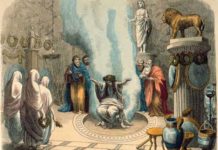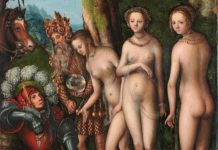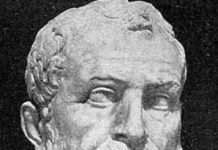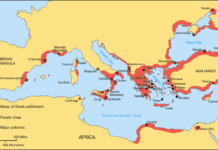Pederasty, or the sexual love of adolescent boys, was a strong part of Ancient Greek culture. It was age-defined and kept within strict social norms. The lover, or erastes, was a man in his twenties. He would court the youth that took his fancy, buying him presents and helping him to progress. He would also mentor the youth and provide a role model for him.
The beloved, or eromenos, was typically between twelve and seventeen years old. His sexual role in the relationship was always that of a passive receiver, and the relationship was expected to end once the boy became a man himself and looked for his own eromenos.
The state of Sparta made homosexual relationships mandatory
In the military totalitarian city state of Sparta, every aspect of life was fully proscribed by the state. All Spartan males underwent full military training from the age of seven years. At the age of twelve or thirteen, this included taking an erastes from among the older men. This older lover was seen as much as a mentor and role model for the Spartan boy as a lover, and the performance of the boy in battle was now the responsibility of his mentor. Thus it was an educational as much as a sexual role.
While there is no doubt that some of the relationships between Spartan men and their protégés in the army were sexual, they did not have to be. Two of the most well known sources of our knowledge about Sparta; Plutarch and Xenophon, stressed that the relationship should consist of “ideal friendship” and that to sexually consummate it would be “an abomination”. Nonetheless, any man who refused to take on a young boy as his protégé would be punished, as it was seen as a duty to raise another Spartan boy to be as good a fighter as yourself.
The homoerotic element cannot be entirely ignored. The Spartan King Agesilaus was mocked by his friends because he drew back from the offered kiss of a very beautiful boy, Megabates. They called him a coward for being afraid of a boy’s caresses, but Agesilaus eventually said he would rather remain above such things, and keep his liberty.
Lesbian and gay women’s relationships in Ancient Sparta
Spartan women benefitted from a degree of autonomy and freedom that was not found anywhere else in ancient Greece. While boys were taken from their mothers at the age of seven to begin military training in an all-male environment, girls remained with their families. They also attended school however, and followed a program parallel to the boys; focusing on physical excellence, music and dance. It was considered as important to bring up girls to be mothers of men as to bring up the boys to be men.
There is no doubt that parallel relationships of erastes and eromenos also existed between Spartan girls and their older role models. We know this partly through the work of the Spartan poet Alkman. His poetry, sung by two competing choirs of Spartan girls to the goddesses and their choir mistresses, reveals idealised love on behalf of the girls for the women.
“Let Astaphis be mine
Have Philylla look my way
And Damareta, and sexy Ianthemis,
But Hagesichora is our saviour
Is not Hagesichora of the lovely ankles here with us?
…only Hagesichora could give the girls the peace they desired.”
Marriage and heterosexual relationships in ancient Sparta
All Spartan men and women were required to marry and beget children. A man who had not married by the appropriate time – his late twenties – was subject to social ridicule, mockery and punishment. He was not permitted to watch the gymnastic festivals of the youth of Sparta (consisting of naked displays of dancing, athletics and martial arts), but was required instead to parade around naked himself, singing songs attesting to his inadequacy and his meriting of punishment.
Marriage customs in Sparta were in fact highly unusual. The bride’s head was shaved and she was dressed as a boy. A mock abduction would be staged, and she would be taken from her father’s house to the barracks of her husband, where she would wait for him in his room. In the morning she would return to her father’s house. For the first few years of marriage, she would visit her husband only at night, and as secretly as possible. Once she had children, her husband would set up house with her, but he was still obliged to eat daily with his fellow soldiers in his mess hall.
If a husband could not make his wife pregnant, or if the babies were defective, it was considered wise for the woman, with her husband’s consent, to seek a lover.
Gay men and women in ancient Sparta
The contradiction of the ancient Greek city state of Sparta is that it was a military totalitarian state which enforced strict social roles for its members, yet within that framework a range of sexual freedoms was permitted. Heterosexuality and homosexuality were both encouraged and expected at different stages in life, with homosexuality, in common with prevalent ancient Greek thought, being seen as the ideal form of love and heterosexuality as essential for procreation.








